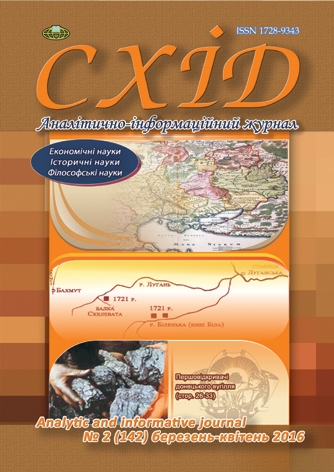Dialogue between fashion and laughter: modern and postmodern correlations
DOI:
https://doi.org/10.21847/1728-9343.2016.2(142).70577Keywords:
laughter, fashion, social functions of laughter, carnivalization of fashion, simulacrization of sociocultural space, objectification of laughter and ironyAbstract
The article explores impacts of laughter on the formation and dynamics of such a socio-cultural phenomenon as fashion, examines the functioning of laughter and fashion in terms of social rhythmics, and illuminates their correlations in stable and transitional states of society.
The paper is focused on the influence exerted by the unconscious on social processes, namely, the existence of certain parallels between ancient trickster myths and the contemporary doctrine of order and chaos. The socio-cultural environment is explicitly interpreted via these observations, entailing the determination of a prominent role of humor as an attractor of social changes. It is asserted that laughter and fashion are in permanent dialogue; their mutual interactions and reciprocal influences allow revealing complex processes inherent in the whole socio-cultural environment.
Contemporary epoch provides examples of impacts made by laughter on both supporting fashion canons in periods of stable society and chaotization of fashion trends in moments of transition in accordance with a carnival type in order to seek new value guidelines and ideologemes. Thus, in modern society with its established development state, laughter performs the function of imposing sanctions on "apostates" of fashion and makes them fit generally accepted norms. The inclusion of modern society in the state of transition immediately influences fashion trends, acting as the destruction of a certain socio-cultural "code" and impetus for carnival mood; all characters, symbols, and archetypes of past epochs, traditions, and civilizational achievements are mixed for the vivification.
However, in contrast, the post-modern period reveals dysfunctional manifestations of comic element. The laughter ceases to be the guardian of fashion and becomes its legislator; it determines the facetiousness as a trend and loses its regulatory and legislative potential. This dysfunction of laughter has disturbed conventional social rhythmics, changing the nature and logic of fashion. Instead of the principle of the substitution of old phenomena by new ones, the principle of supplements and parallel existence of all possible styles dominates in today's fashion, leading to a great diversity of both negative and positive transformations.Downloads
References
Svendsen L. (2007), Philosophy of Fashion, Progress-Traditsiya, Moscow, 256 p. (rus).
Leopardi G. (2000), Dialogue between Fashion and Death, in Nravstvennye ocherki. Dnevnik razmyshleniy. Mysli, Respublika, Moscow, p. 448. (rus).
Dykhnych L. (2002), The phenomenon of fashion in sociocultural processes of the twentieth century, Abstract of thesis for the degree of candidate of historical sciences in specialty 17.00.01 «Theory and history of culture», Kyiv, p. 20. (ukr).
Bart R. (2003), Fashion System. Articles on the Semiotics of Culture, The Sabashnikovs’ Publishing House, Moscow, 512 p. (rus).
Durkheim E. (1991), The Division of Labour in Society, Nauka, Moscow, p. 576. (rus).
Durkheim E. (1995), Sociology and Its Scientific Domain, Kanon, Moscow, p. 352. (rus).
Mann O. (1998), Dandyism as a Conservative Form of Life, in Volshebnaya gora. Moskovskiy filosofskiy zhurnal, Vol. 7, p. 5 (rus).
Khlebnikov V. (1999), Spell of Laughter, in Poeziya russkogo futurizma, Saint Petersburg, pp. 4-5 (rus).
Zimmel G. (1996), Fashion, in Izbrannoye. T. 2. Sozertsaniye zhizni, Moscow, p. 607 (rus).
Baudrillard J. (2004), Symbolic Exchange and Death, Kalvaria, Lviv, p. 376 (ukr).
Maltseva O. (2013), Laughter as a Regulator of Fashion Trends, in The dynamics of scientific research - 2013: ІХ the International scientific-practical conference, Przemyšl, Vol. 6, pp. 72-74 (ukr).
Lipovetsky G. (2001), Era of Emptiness: An Essay on Modern Individualism, Vladimir Dostal, Saint Petersburg, p. 331 (rus).
Maltseva O. (2013), Fashion of the Postmodern Era: Everything for Laughter, Fun, and Entertainment, The dynamics of modern science-2013: IX International Scientific Park. conf., Sofia, Vol. 5, pp. 54-56 (ukr).
Pelevin V. (2007), Empire V, Eksmo, Moscow, p. 416 (rus).
Pelevin V. (2013), Batman Apollo, Ogonyok, Vol. 10, pp. 46-47 (rus).
Baudrillard J. (1998), The Illusion of the End, Elementy, Vol. 9, pp. 34-42 (rus).
Downloads
Published
How to Cite
Issue
Section
License
Copyright (c) 2016 Olha Maltseva

This work is licensed under a Creative Commons Attribution-NonCommercial-NoDerivatives 4.0 International License.
1. Authors bear responsibility for the accuracy of facts, quotations, numbers and names used.
2. Manuscripts are not sent back.
3. The publisher does not always agree with the authors' opinion.
4. The authors reserve the right to authorship of the work and pass the first publication right of this work to the journal under the terms of a Creative Commons Attribution-NonCommercial-NoDerivatives 4.0 International License. This license allows others to distribute (copy) the published work for non-commercial purposes, provided there is mandatory attribution to its authors and a link to the first publication in our journal.
5. The authors have the right to conclude separate supplement agreements that relate to non-exclusive work distribution in the form in which it has been published by the journal (for example, to upload the work to the online storage of the journal or publish it as part of a monograph), provided that the reference to the first publication of the work in this journal is included.

